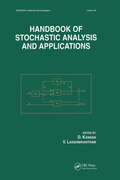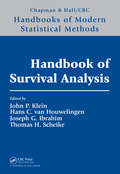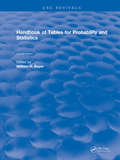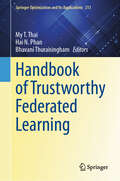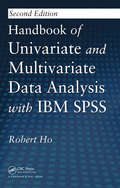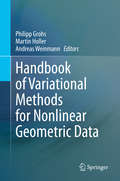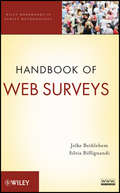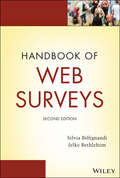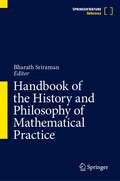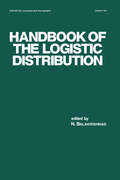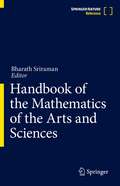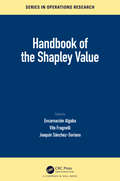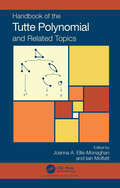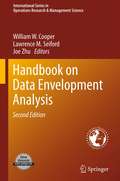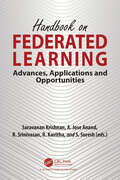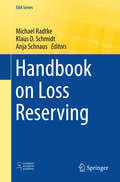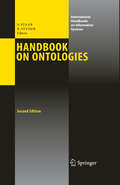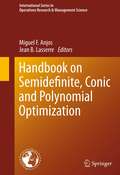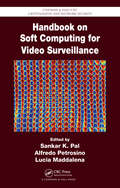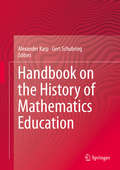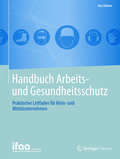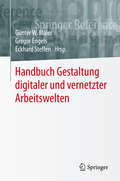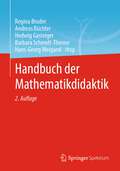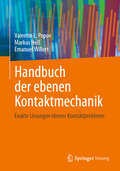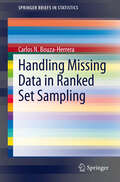- Table View
- List View
Handbook of Stochastic Analysis and Applications (Statistics: A Series of Textbooks and Monographs)
by V. Lakshmikantham D. KannanAn introduction to general theories of stochastic processes and modern martingale theory. The volume focuses on consistency, stability and contractivity under geometric invariance in numerical analysis, and discusses problems related to implementation, simulation, variable step size algorithms, and random number generation.
Handbook of Survival Analysis (Chapman & Hall/CRC Handbooks of Modern Statistical Methods)
by John P. Klein Joseph G. Ibrahim Thomas H. Scheike Hans C. van HouwelingenHandbook of Survival Analysis presents modern techniques and research problems in lifetime data analysis. This area of statistics deals with time-to-event data that is complicated by censoring and the dynamic nature of events occurring in time.With chapters written by leading researchers in the field, the handbook focuses on advances in survival analysis techniques, covering classical and Bayesian approaches. It gives a complete overview of the current status of survival analysis and should inspire further research in the field. Accessible to a wide range of readers, the book provides:An introduction to various areas in survival analysis for graduate students and novicesA reference to modern investigations into survival analysis for more established researchers A text or supplement for a second or advanced course in survival analysisA useful guide to statistical methods for analyzing survival data experiments for practicing statisticians
Handbook of Tables for Probability and Statistics
by William H. BeyerPracticing statisticians and scientists working in diverse fields need an authoritative reference handbook of statistical tables developed to "aid" in the investigation and solution of many of today's challenging problems. This book has been compiled and arranged to meet the needs of these users of statistics.
Handbook of Trustworthy Federated Learning (Springer Optimization and Its Applications #213)
by My T. Thai Bhavani Thuraisingham Hai N. PhanThis handbook aims to serve as a one-stop, reliable resource, including curated surveys and expository contributions on federated learning. It covers a comprehensive range of topics, providing the reader with technical and non-technical fundamentals, applications, and extensive details of various topics. The readership spans from researchers and academics to practitioners who are deeply engaged or are starting to venture into the realms of trustworthy federated learning. First introduced in 2016, federated learning allows devices to collaboratively learn a shared model while keeping raw data localized, thus promising to protect data privacy. Since its introduction, federated learning has undergone several evolutions. Most importantly, its evolution is in response to the growing recognition that its promise of collaborative learning is inseparable from the imperatives of privacy preservation and model security. The resource is divided into four parts. Part 1 (Security and Privacy) explores the robust defense mechanisms against targeted attacks and addresses fairness concerns, providing a multifaceted foundation for securing Federated Learning systems against evolving threats. Part 2 (Bilevel Optimization) unravels the intricacies of optimizing performance in federated settings. Part 3 (Graph and Large Language Models) addresses the challenges in training Graph Neural Networks and ensuring privacy in Federated Learning of natural language models. Part 4 (Edge Intelligence and Applications) demonstrates how Federated Learning can empower mobile applications and preserve privacy with synthetic data.
Handbook of Univariate and Multivariate Data Analysis with IBM SPSS
by Robert HoUsing the same accessible, hands-on approach as its best-selling predecessor, the Handbook of Univariate and Multivariate Data Analysis with IBM SPSS, Second Edition explains how to apply statistical tests to experimental findings, identify the assumptions underlying the tests, and interpret the findings. This second edition now covers more topics
Handbook of Variational Methods for Nonlinear Geometric Data
by Philipp Grohs Martin Holler Andreas WeinmannThis book covers different, current research directions in the context of variational methods for non-linear geometric data. Each chapter is authored by leading experts in the respective discipline and provides an introduction, an overview and a description of the current state of the art. Non-linear geometric data arises in various applications in science and engineering. Examples of nonlinear data spaces are diverse and include, for instance, nonlinear spaces of matrices, spaces of curves, shapes as well as manifolds of probability measures. Applications can be found in biology, medicine, product engineering, geography and computer vision for instance. Variational methods on the other hand have evolved to being amongst the most powerful tools for applied mathematics. They involve techniques from various branches of mathematics such as statistics, modeling, optimization, numerical mathematics and analysis. The vast majority of research on variational methods, however, is focused on data in linear spaces. Variational methods for non-linear data is currently an emerging research topic. As a result, and since such methods involve various branches of mathematics, there is a plethora of different, recent approaches dealing with different aspects of variational methods for nonlinear geometric data. Research results are rather scattered and appear in journals of different mathematical communities. The main purpose of the book is to account for that by providing, for the first time, a comprehensive collection of different research directions and existing approaches in this context. It is organized in a way that leading researchers from the different fields provide an introductory overview of recent research directions in their respective discipline. As such, the book is a unique reference work for both newcomers in the field of variational methods for non-linear geometric data, as well as for established experts that aim at to exploit new research directions or collaborations.Chapter 9 of this book is available open access under a CC BY 4.0 license at link.springer.com.
Handbook of Web Surveys
by Jelke Bethlehem Silvia BiffignandiBEST PRACTICES TO CREATE AND IMPLEMENTHIGHLY EFFECTIVE WEB SURVEYSExclusively combining design and sampling issues, Handbook of Web Surveys presents a theoretical yet practical approach to creating and conducting web surveys. From the history of web surveys to various modes of data collection to tips for detecting error, this book thoroughly introduces readers to the this cutting-edge technique and offers tips for creating successful web surveys.The authors provide a history of web surveys and go on to explore the advantages and disadvantages of this mode of data collection. Common challenges involving under-coverage, self-selection, and measurement errors are discussed as well as topics including:Sampling designs and estimation proceduresComparing web surveys to face-to-face, telephone, and mail surveysErrors in web surveysMixed-mode surveysWeighting techniques including post-stratification, generalized regression estimation, and raking ratio estimationUse of propensity scores to correct biasWeb panelsReal-world examples illustrate the discussed concepts, methods, and techniques, with related data freely available on the book's Website. Handbook of Web Surveys is an essential reference for researchers in the fields of government, business, economics, and the social sciences who utilize technology to gather, analyze, and draw results from data. It is also a suitable supplement for survey methods courses at the upper-undergraduate and graduate levels.
Handbook of Web Surveys (Wiley Handbooks in Survey Methodology)
by Jelke Bethlehem Silvia BiffignandiThe updated, must-have guide for creating and implementing web surveys Revised and thoroughly updated, the second edition of Handbook of Web Surveys offers a practical and comprehensive guide for creating and conducting effective web surveys. The authors noted experts on the topic, include a review the Blaise system (which has been around for 30 years) and provide information on the most recent developments and techniques in the field. The book illustrates the steps needed to develop effective web surveys and explains how the survey process should be carried out. It also examines the aspects of sampling and presents a number of sampling designs. The book includes ideas for overcoming possible errors in measurement and nonresponse. The authors also compare the various methods of data collection (face-to-face, telephone, mail, and mobile surveys) and discuss their advantages and disadvantages. Critical information for designing questionnaires for mobile devices is also provided. Filled with real-world examples, Handbook of Web Surveys discuss the key concepts, methods, and techniques of effective web surveys. This important book: Contains the most recent sampling designs and estimation procedures Offers ideas for overcoming errors in web surveys Includes information on mixed mode surveys Explores the concept of response probabilities Reviews all aspects of web panels Written for researchers in government, business, economics, and social scientists, the second edition of Handbook of Web Surveys provides an introduction to web surveys and the various methods and techniques.
Handbook of the History and Philosophy of Mathematical Practice
by Bharath SriramanThe purpose of this unique handbook is to examine the transformation of the philosophy of mathematics from its origins in the history of mathematical practice to the present. It aims to synthesize what is known and what has unfolded so far, as well as to explore directions in which the study of the philosophy of mathematics, as evident in increasingly diverse mathematical practices, is headed. Each section offers insights into the origins, debates, methodologies, and newer perspectives that characterize the discipline today. Contributions are written by scholars from mathematics, history, and philosophy – as well as other disciplines that have contributed to the richness of perspectives abundant in the study of philosophy today – who describe various mathematical practices throughout different time periods and contrast them with the development of philosophy. Editorial Advisory Board Andrew Aberdein, Florida Institute ofTechnology, USA Jody Azzouni, Tufts University, USA Otávio Bueno, University of Miami, USA William Byers, Concordia University, Canada Carlo Cellucci, Sapienza University of Rome, Italy Chandler Davis, University of Toronto, Canada (1926-2022) Paul Ernest, University of Exeter, UK Michele Friend, George Washington University, USA Reuben Hersh, University of New Mexico, USA (1927-2020) Kyeong-Hwa Lee, Seoul National University, South Korea Yuri Manin, Max Planck Institute for Mathematics, Germany (1937-2023) Athanase Papadopoulos, University of Strasbourg, France Ulf Persson, Chalmers University of Technology, Sweden John Stillwell, University of San Francisco, USA David Tall, University of Warwick, UKThis book with its exciting depth and breadth, illuminates us about the history, practice, and the very language of our subject; about the role of abstraction, ofproof and manners of proof; about the interplay of fundamental intuitions; about algebraic thought in contrast to geometric thought. The richness of mathematics and the philosophy encompassing it is splendidly exhibited over the wide range of time these volumes cover---from deep platonic and neoplatonic influences to the most current experimental approaches. Enriched, as well, with vivid biographies and brilliant personal essays written by (and about) people who play an important role in our tradition, this extraordinary collection of essays is fittingly dedicated to the memory of Chandler Davis, Reuben Hersh, and Yuri Manin.---Barry Mazur, Gerhard Gade University Professor, Harvard UniversityThis encyclopedic Handbook will be a treat for all those interested in the history and philosophy of mathematics. Whether one is interested in individuals (from Pythagoras through Newton and Leibniz to Grothendieck), fields (geometry, algebra, number theory, logic, probability, analysis), viewpoints (from Platonism to Intuitionism), or methods (proof, experiment, computer assistance), the reader will find a multitude of chapters that inform and fascinate.---John Stillwell, Emeritus Professor of Mathematics, University of San Francisco; Recipient of the 2005 Chauvenet PrizeDedicating a volume to the memory of three mathematicians – Chandler Davis, Reuben Hersh, and Yuri Manin –, who went out of their way to show to a broader audience that mathematics is more than what they might think, is an excellent initiative. Gathering authors coming from many different backgrounds but who are very strict about the essays they write was successfully achieved by the editor-in-chief. The result: a great source of potential inspiration!---Jean-Pierre Bourguignon; Nicolaas Kuiper Honorary Professor at the Institut des Hautes Études Scientifiques
Handbook of the Logistic Distribution
by N. BalakrishnanThis book highlights various theoretical developments on logistic distribution, illustrates the practical utility of these results, and describes univariate and multivariate generalizations of the distribution. It is useful for researchers, practicing statisticians, and graduate students.
Handbook of the Mathematics of the Arts and Sciences
by Bharath SriramanThe goal of this Handbook is to become an authoritative source with chapters that show the origins, unification, and points of similarity between different disciplines and mathematics. Some chapters will also show bifurcations and the development of disciplines which grow to take on a life of their own. Science and Art are used as umbrella terms to encompass the physical, natural and geological sciences, as well as the visual and performing arts. As arts imagine possibilities, science attempts to generate models to test possibilities, mathematics serves as the tool. This handbook is an indispensable collection to understand todays effort to build bridges between disciplines. It answers questions such as: What are the origins of interdisciplinarity in mathematics? What are cross-cultural components of interdisciplinarity linked to mathematics? What are contemporary interdisciplinary trends? Section Editors:Michael J. Ostwald, University of Newcastle (Australia)Kyeong-Hwa Lee, Seoul National University (South Korea)Torsten Lindström, Linnaeus University (Sweden)Gizem Karaali, Pomona College (USA)Ken Valente, Colgate University, (USA) Consulting Editors:Alexandre Borovik, Manchester University (UK)Daina Taimina, Independent Scholar, Cornell University (USA)Nathalie Sinclair, Simon Fraser University (Canada)What do figure skating, invasive species, medieval cathedrals, ropes, poems, wines, metaphors, rhythms, climate change, and origami have in common? Mathematics! The Handbook of the Mathematics of the Arts and Sciences is a stunning compendium of essays on these and scores of other unlikely subjects to which the mathematical imagination has been brought. It is at once a dazzlingly contemporary tour of human success at bringing order to the world, and a throwback to a time before the “unity of knowledge” became a mere slogan. It is a breathtaking work, for its ambitious scope and for its endless stimulation of the reader’s curiosity.- Harry R. Lewis, Gordon McKay Research Professor of Computer Science at Harvard University, editor of Ideas That Created the Future: Classic Papers of Computer ScienceMathematics has always enjoyed deep connections with the arts, science, the humanities, philosophy, history, and society in general. However, these links are often overlooked or undervalued. This Handbook makes a massive statement about the extent and importance of the interdisciplinary nature of mathematics, and its relevance to all aspects of human culture. Its articles are scholarly and authoritative, but also highly readable and accessible to non-specialists. A triumph! -Ian Stewart FRS, Emeritus Professor - University of WarwickThis handbook will delight anyone who loves the richness of mathematics and its interplay with the arts and humanities. Bharath Sriraman has given us a great gift, a treasure chest of connections to art and architecture, language and literature, philosophy, history, society, you name it. The book is authoritative and charming and instantly establishes itself as a landmark reference for interdisciplinary mathematics. Steven Strogatz - Jacob Gould Schurman Professor of Applied Mathematics at Cornell University.
Handbook of the Shapley Value (Chapman & Hall/CRC Series in Operations Research)
by Encarnación Algaba, Vito Fragnelli and Joaquín Sánchez-SorianoHandbook of the Shapley Value contains 24 chapters and a foreword written by Alvin E. Roth, who was awarded the Nobel Memorial Prize in Economic Sciences jointly with Lloyd Shapley in 2012. The purpose of the book is to highlight a range of relevant insights into the Shapley value. Every chapter has been written to honor Lloyd Shapley, who introduced this fascinating value in 1953. The first chapter, by William Thomson, places the Shapley value in the broader context of the theory of cooperative games, and briefly introduces each of the individual contributions to the volume. This is followed by a further contribution from the editors of the volume, which serves to introduce the more significant features of the Shapley value. The rest of the chapters in the book deal with different theoretical or applied aspects inspired by this interesting value and have been contributed specifically for this volume by leading experts in the area of Game Theory. Chapters 3 through to 10 are more focused on theoretical aspects of the Shapley value, Chapters 11 to 15 are related to both theoretical and applied areas. Finally, from Chapter 16 to Chapter 24, more attention is paid to applications of the Shapley value to different problems encountered across a diverse range of fields. As expressed by William Thomson in the Introduction to the book, "The chapters contribute to the subject in several dimensions: Mathematical foundations; axiomatic foundations; computations; applications to special classes of games; power indices; applications to enriched classes of games; applications to concretely specified allocation problems: an ever-widening range, mapping allocation problems into games or implementation." Nowadays, the Shapley value continues to be as appealing as when it was first introduced in 1953, or perhaps even more so now that its potential is supported by the quantity and quality of the available results. This volume collects a large amount of work that definitively demonstrates that the Shapley value provides answers and solutions to a wide variety of problems.
Handbook of the Tutte Polynomial and Related Topics
by Joanna A. Ellis-Monaghan Iain MoffattThe Tutte Polynomial touches on nearly every area of combinatorics as well as many other fields, including statistical mechanics, coding theory, and DNA sequencing. It is one of the most studied graph polynomials. Handbook of the Tutte Polynomial and Related Topics is the first handbook published on the Tutte Polynomial. It consists of thirty-four chapters, written by experts in the field, that collectively offer a concise overview of the polynomial’s many properties and applications. Each chapter covers a different aspect of the Tutte polynomial, and contains the central results and references for its topic. The chapters are organized in six parts. Part I describes the fundamental properties of the Tutte polynomial, providing an overview of the Tutte polynomial and the necessary background for the rest of the handbook. Part II is concerned with questions of computation, complexity and approximation for the Tutte polynomial; Part III covers a selection of related graph polynomials; Part IV discusses a range of applications of the Tutte polynomial to mathematics, physics, and biology; Part V includes various extensions and generalizations of the Tutte polynomial; Part VI provides a history of the development of the Tutte polynomial. Features Written in an accessible style for non-experts yet extensive enough for experts. Serves as a comprehensive and accessible introduction to the theory of graph polynomials for researchers in mathematics, physics, and computer science. Provides an extensive reference volume for the evaluations, theorems, and properties of the Tutte polynomial and related graph, matroid, and knot invariants. Offers broad coverage, touching on the wide range of applications of the Tutte polynomial and its various specializations.
Handbook on Data Envelopment Analysis
by Joe Zhu William W. Cooper Lawrence M. SeifordThis handbook covers DEA topics that are extensively used and solidly based. The purpose of the handbook is to (1) describe and elucidate the state of the field and (2), where appropriate, extend the frontier of DEA research. It defines the state-of-the-art of DEA methodology and its uses. This handbook is intended to represent a milestone in the progression of DEA. Written by experts, who are generally major contributors to the topics to be covered, it includes a comprehensive review and discussion of basic DEA models, which, in the present issue extensions to the basic DEA methods, and a collection of DEA applications in the areas of banking, engineering, health care, and services. The handbook's chapters are organized into two categories: (i) basic DEA models, concepts, and their extensions, and (ii) DEA applications. First edition contributors have returned to update their work. The second edition includes updated versions of selected first edition chapters. New chapters have been added on: different approaches with no need for a priori choices of weights (called "multipliers) that reflect meaningful trade-offs, construction of static and dynamic DEA technologies, slacks-based model and its extensions, DEA models for DMUs that have internal structures network DEA that can be used for measuring supply chain operations, Selection of DEA applications in the service sector with a focus on building a conceptual framework, research design and interpreting results.
Handbook on Federated Learning: Advances, Applications and Opportunities
by S. Suresh R. Srinivasan Saravanan Krishnan A. Jose Anand R. KavithaMobile, wearable, and self-driving telephones are just a few examples of modern distributed networks that generate enormous amount of information every day. Due to the growing computing capacity of these devices as well as concerns over the transfer of private information, it has become important to process the part of the data locally by moving the learning methods and computing to the border of devices. Federated learning has developed as a model of education in these situations. Federated learning (FL) is an expert form of decentralized machine learning (ML). It is essential in areas like privacy, large-scale machine education and distribution. It is also based on the current stage of ICT and new hardware technology and is the next generation of artificial intelligence (AI). In FL, central ML model is built with all the data available in a centralised environment in the traditional machine learning. It works without problems when the predictions can be served by a central server. Users require fast responses in mobile computing, but the model processing happens at the sight of the server, thus taking too long. The model can be placed in the end-user device, but continuous learning is a challenge to overcome, as models are programmed in a complete dataset and the end-user device lacks access to the entire data package. Another challenge with traditional machine learning is that user data is aggregated at a central location where it violates local privacy policies laws and make the data more vulnerable to data violation. This book provides a comprehensive approach in federated learning for various aspects.
Handbook on Loss Reserving (EAA Series)
by Michael Radtke Klaus D. Schmidt Anja SchnausThis handbook presents the basic aspects of actuarial loss reserving. Besides the traditional methods, it also includes a description of more recent ones and a discussion of certain problems occurring in actuarial practice, like inflation, scarce data, large claims, slow loss development, the use of market statistics, the need for simulation techniques and the task of calculating best estimates and ranges of future losses. In property and casualty insurance the provisions for payment obligations from losses that have occurred but have not yet been settled usually constitute the largest item on the liabilities side of an insurer's balance sheet. For this reason, the determination and evaluation of these loss reserves is of considerable economic importance for every property and casualty insurer. Actuarial students, academics as well as practicing actuaries will benefit from this overview of the most important actuarial methods of loss reserving by developing an understanding of the underlying stochastic models and how to practically solve some problems which may occur in actuarial practice.
Handbook on Ontologies
by Rudi Studer Steffen StaabAn ontology is a formal description of concepts and relationships that can exist for a community of human and/or machine agents. The notion of ontologies is crucial for the purpose of enabling knowledge sharing and reuse. The Handbook on Ontologies provides a comprehensive overview of the current status and future prospectives of the field of ontologies considering ontology languages, ontology engineering methods, example ontologies, infrastructures and technologies for ontologies, and how to bring this all into ontology-based infrastructures and applications that are among the best of their kind. The field of ontologies has tremendously developed and grown in the five years since the first edition of the "Handbook on Ontologies". Therefore, its revision includes 21 completely new chapters as well as a major re-working of 15 chapters transferred to this second edition.
Handbook on Semidefinite, Conic and Polynomial Optimization
by Miguel F. Anjos Jean B. LasserreSemidefinite and conic optimization is a major and thriving research area within the optimization community. Although semidefinite optimization has been studied (under different names) since at least the 1940s, its importance grew immensely during the 1990s after polynomial-time interior-point methods for linear optimization were extended to solve semidefinite optimization problems. Since the beginning of the 21st century, not only has research into semidefinite and conic optimization continued unabated, but also a fruitful interaction has developed with algebraic geometry through the close connections between semidefinite matrices and polynomial optimization. This has brought about important new results and led to an even higher level of research activity. This Handbook on Semidefinite, Conic and Polynomial Optimization provides the reader with a snapshot of the state-of-the-art in the growing and mutually enriching areas of semidefinite optimization, conic optimization, and polynomial optimization. It contains a compendium of the recent research activity that has taken place in these thrilling areas, and will appeal to doctoral students, young graduates, and experienced researchers alike. The Handbook's thirty-one chapters are organized into four parts: Theory, covering significant theoretical developments as well as the interactions between conic optimization and polynomial optimization;Algorithms, documenting the directions of current algorithmic development;Software, providing an overview of the state-of-the-art;Applications, dealing with the application areas where semidefinite and conic optimization has made a significant impact in recent years.
Handbook on Soft Computing for Video Surveillance (Chapman & Hall/CRC Cryptography and Network Security Series)
by Sankar K. Pal Alfredo Petrosino Lucia MaddalenaInformation on integrating soft computing techniques into video surveillance is widely scattered among conference papers, journal articles, and books. Bringing this research together in one source, Handbook on Soft Computing for Video Surveillance illustrates the application of soft computing techniques to different tasks in video surveillance. Wor
Handbook on the History of Mathematics Education
by Alexander Karp Gert SchubringThis is the first comprehensive International Handbook on the History of Mathematics Education, covering a wide spectrum of epochs and civilizations, countries and cultures. Until now, much of the research into the rich and varied history of mathematics education has remained inaccessible to the vast majority of scholars, not least because it has been written in the language, and for readers, of an individual country. And yet a historical overview, however brief, has become an indispensable element of nearly every dissertation and scholarly article. This handbook provides, for the first time, a comprehensive and systematic aid for researchers around the world in finding the information they need about historical developments in mathematics education, not only in their own countries, but globally as well. Although written primarily for mathematics educators, this handbook will also be of interest to researchers of the history of education in general, as well as specialists in cultural and even social history.
Handbuch Arbeits- und Gesundheitsschutz
by Institut für angewandte ArbeitswissenschDieses Handbuch dient als Praxisleitfaden für Arbeits- und Gesundheitsschutzbeauftragte. Es gibt Hilfestellung beim Aufbau der Organisation des betrieblichen Arbeits- und Gesundheitsschutzes. Dies soll Unternehmen dazu befähigen, basierend auf den gesetzlichen Anforderungen ein zum jeweiligen Betrieb passendes System zu installieren. Neben der rechtlichen Einordnung beschreiben die Autoren in kleinen Schritten und praxisgerecht die erforderlichen planerischen und organisatorischen Aspekte. Das Handbuch enthält Vorlagen und Checklisten. Diese können direkt verwendet und auf die eigenen betrieblichen Belange angepasst werden. Unternehmen, die das Handbuch nutzen und mit Leben füllen, haben damit die Grundlage für ein Arbeitsschutzsystem geschaffen, dass zu einem Arbeitsschutzmanagement ausgebaut werden kann. Dieses Handbuch wird Betriebspraktiker interessieren, ihnen hilfreiche Impulse für die eigene Arbeit sowie für die Umsetzung vor Ort geben.
Handbuch Gestaltung digitaler und vernetzter Arbeitswelten (Springer Reference Psychologie Ser.)
by Gregor Engels Günter W. Maier Eckhard SteffenDieses interdisziplinäre Handbuch richtet sich an all diejenigen, die den digitalen Wandel, der im Zusammenhang mit der vierten industriellen Revolution (Industrie 4.0) diskutiert wird, in Betrieben, Verwaltungen und der Gesellschaft besser verstehen und aktiv gestalten möchten. Die einzelnen Beiträge veranschaulichen die vielfältigen Perspektiven unterschiedlicher Disziplinen (z.B. Ingenieur-, Rechts- und Wirtschaftswissenschaften, Informatik, Psychologie, Soziologie, Erziehungswissenschaft u.a.) oder Interessensgruppen (z.B. Gewerkschaften) auf die Folgen der Digitalisierung im Arbeitsleben für Mensch, Organisation und Gesellschaft. Das gesamte Werk schlägt eine Brücke von aktuellen Forschungsergebnissen hin zu praktischen Umsetzungshinweisen. Im Zentrum stehen drei zentrale Fragen zur Digitalisierung des Arbeitslebens, und zwar woran man sich bei der Gestaltung orientieren, wie die Transformation gestaltet werden und worauf sich die Digitalisierung auswirken kann. Beispielthemen dieser 3 Bereiche: 1. Im Zusammenhang mit den Gestaltungskriterien: sichere und gesundheitsförderliche Gestaltung der digitalen Arbeitsweltarbeitsrechtliche Aspektepsychologische Arbeitsgestaltung digitaler Arbeitswelten 2. Im Zusammenhang mit der Art und Weise des Wandels von analogen zu digitalen Arbeitswelten: Chancen für gesundheitsorientierte Arbeitsgestaltung durch körpernahe und tragbare Sensorik neue Aufgabenverteilung durch kollaborative Roboter im Rahmen der Mitbestimmung Prozesse durch proaktive betriebliche Interessensvertretung gestalten 3. Im Zusammenhang mit den Konsequenzen: Auswirkungen digitaler Arbeitswelten auf die Beschäftigungsstrukturen und das Privatleben Möglichkeiten dieser Entwicklung für die Inklusion älterer Menschen oder Menschen mit Behinderung ZielgruppenAnwender/innen und Entwickler/innen digitaler Technologien, Führungskräfte, Personalleiter/innen und Entscheidungsträger/innen in Unternehmen, Verbänden und der Politik
Handbuch der Mathematikdidaktik
by Regina Bruder Barbara Schmidt-Thieme Hans-Georg Weigand Andreas Büchter Hedwig GasteigerDieses Handbuch gibt einen aktuellen Überblick über Forschungsgebiete der Mathematikdidaktik. In 26 Kapiteln stellen führende Vertreterinnen und Vertreter der Disziplin Diskussionsstände zu Mathematik als Bildungsgegenstand, als Lehr- und Lerninhalt, als Denkprozess sowie zu Mathematik im Unterrichtsprozess und zur Mathematikdidaktik als Forschungsdisziplin dar. Seit der 1. Auflage des Handbuchs im Jahr 2015 hat sich die Forschung auf allen dargestellten Gebieten so weiterentwickelt, dass eine gründliche Überarbeitung und Erweiterung erforderlich wurde. An der 2. Auflage haben zahlreiche neue Autorinnen und Autoren mitgewirkt, einzelne Kapitel wurden ergänzt, Themengebiete der Primarstufe finden nun eine größere Beachtung und es wurde stärker auf historische bzw. fachliche und fachdidaktische Entwicklungen aus einer Metaperspektive eingegangen. Das Handbuch wurde geschriebenfür im Studium fortgeschrittene Studierende als eine grundlegende und einführende Lektüre für ein Referat, eine Hausarbeit oder eine Abschlussarbeit in der Mathematikdidaktik;für Masterstudierende und angehende Promovierende zu Beginn einer eigenen Forschungsarbeit in der Mathematikdidaktik;für Lehrerinnen und Lehrer zum Kennenlernen forschungsbasierter Fragestellungen in der Mathematikdidaktik sowie als Grundlage für theoriegeleitete Reflexionen über eigenen oder fremden Unterricht;für Mathematikdidaktikerinnen und -didaktiker, die sich einen Überblick über zentrale Themen und derzeit aktuelle Forschungsfragen in verschiedenen Teilbereichen ihrer Disziplin verschaffen möchten.
Handbuch der ebenen Kontaktmechanik: Exakte Lösungen ebener Kontaktprobleme
by Valentin L. Popov Markus Heß Emanuel WillertDas Buch beinhaltet eine strukturierte Sammlung der vollständigen Lösungen aller wesentlichen ebenen Kontaktprobleme. Es werden klassische Profile – wie der Zylinder, der Keil oder der quaderförmige flache Stempel – unter zentrischer und exzentrischer Belastung behandelt, aber auch eine Vielzahl weiterer technisch relevanter Formen, wie der flache Stempel mit abgerundeten Kanten, der Keil mit abgerundeter Spitze oder wellige Oberflächen. In Bezug auf die Lastkonfiguration werden adhäsive und adhäsionsfreie Normalkontakte, Tangentialkontakte und Rollkontakte berücksichtigt. Als Materialien kommen elastisch isotrope, transversal isotrope, viskoelastische und funktionale Gradientenmedien zur Sprache. Die angegebenen Lösungen werden jeweils auf dem einfachsten zur Verfügung stehenden Weg hergeleitet und umfassen neben den makroskopischen Zusammenhängen zwischen der Last und der Kontaktkonfiguration die Spannungsfelder in der Oberfläche und gegebenenfalls innerhalb der Kontaktkörper.
Handling Missing Data in Ranked Set Sampling
by Carlos N. Bouza-HerreraThe existence of missing observations is a very important aspect to be considered in the application of survey sampling, for example. In human populations they may be caused by a refusal of some interviewees to give the true value for the variable of interest. Traditionally, simple random sampling is used to select samples. Most statistical models are supported by the use of samples selected by means of this design. In recent decades, an alternative design has started being used, which, in many cases, shows an improvement in terms of accuracy compared with traditional sampling. It is called Ranked Set Sampling (RSS). A random selection is made with the replacement of samples, which are ordered (ranked). The literature on the subject is increasing due to the potentialities of RSS for deriving more effective alternatives to well-established statistical models. In this work, the use of RSS sub-sampling for obtaining information among the non respondents and different imputation procedures are considered. RSS models are developed as counterparts of well-known simple random sampling (SRS) models. SRS and RSS models for estimating the population using missing data are presented and compared both theoretically and using numerical experiments.
